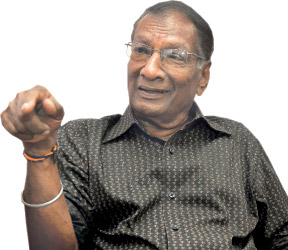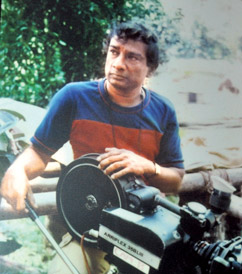|

Camera by stealth
Channa Bandara Wijekoon
He initiated his career in 1957 as an apprentice in B A W Jayamanne's
crew. And this was when South India was influencing the local cinema.
His task was to get along with Indian technicians to work on technical
specifications.
 |
|
Vamadevan.
Picture by Wasitha Patabendige |
Yes, learning the finer points in the cine camera was a far cry back
then, especially when the Indians worked strictly on a 'need-to-know'
basis. He had to explore the depths of film shooting by himself. This
process of 'learning the hard way' eventually made him an extraordinary
cinematographer.
And that is how V Vamadevan, very much active despite being 76 in
age, gets in touch with the 'Encounter of the Week'.
Q: You entered the celluloid world way back in 1957 when local
cinema was relying on South Indian expertise.
A. I started my career in 1957 at the beginning of Ceylon
Studios. The pioneer B A W Jayamanne was my mentor.
I was the assistant cameraman of 'Oba Dutu Daa', 'Wanaliya', 'Hadisi
Vivahaya' and 'Kawata Andarae'. M D Sumanasekera was the only local
cameraman in Ceylon studios who had learned in R K Studio, Bombay. He
shared his knowledge with me like a father.
During that time Cinemas Limited used to make films in the famous
Modern Studios in South India owned by T R Sundaram. Married to a Swiss
lady, Sundaram was well respected by both local and Indian film makers.
Sundaram was an authoritarian and a very punctual man. When he entered
the sets (studio) saying "Start...", the shooting had to start.
I joined Cinemas Limited in 1960 hoping to travel to South India and
sharpening my skills.
Cinemas Limited acquired cameras after doing 'Sandeshaya'. Its owner
K Gunaratnam on commissioning Vijeya studios got down M Mastan from
South India as his technical director. Asokamala was filmed by Mastan.
Q: How was your progress from there onwards?
A: When the Bandaranaike government came into power in 1970,
they prohibited going to India to make films and provided facilities to
do it locally.
 Thus we started emerging as promising cameraman. Vijeya Studios did
'Adata Wediya Heta Hondai' with the cast of Ananda Jayaratne, Gamini
Fonseka, Jeewarani and Sandya Kumari and I was the cameraman. Thus we started emerging as promising cameraman. Vijeya Studios did
'Adata Wediya Heta Hondai' with the cast of Ananda Jayaratne, Gamini
Fonseka, Jeewarani and Sandya Kumari and I was the cameraman.
It was smooth sailing for me since then.
Q: Unforgettable memories with the cine camera?
A: One such incident was K Guneratnam calling me to finish the
incomplete work in the camera department, when the hired cameraman
buckled shooting of 'Aathma Pooja'.
I took the challenge and did it. Gamini Fonseka's double acting
scenes in the film (you may recall the sword fighting scene which
involved two Gamini Fonsekas) was done by me with the guidance of
Mastan.
Sri Lankan born Tamilnadu star MGR was spellbound to see how we have
filmed the fight scene in 'Soorayangeth Sooraya' between Gamini and
Alexander Fernando. We were experimenting to surpass South Indian films
at the time.
Remember, we did all that at a time when the word 'special effects'
was not even heard of. Lenin Moraeus was introduced to Sinhala cinema by
me.
Q: How do you define and distinguish your way of filming with
the others?
A: I have highlighted the 'mood' aspect in my works. I was
mindful of low-key and high-key lighting in photography. Alfred
Hitchcock films were made using low-key lighting. Jerry Lewis films
(comedy) were mostly high-key.
Certain cameramen light-up a 'night scene' to give a 'Deepavali' mood
which is not appropriate. I tried to use lighting and camera according
to the scene and mood elaborated in the script and the director's
wishes. It helps the actor also to grasp the right mood to perform.
Some filmmakers harp on 'zooming aspect'. Zoom is not there to use
often. The audience should not feel when the zoom happens. It has to be
in perfect harmony with the storyline and the scene.
The cameraman, the music director or any other person in the project
for that matter must comply with the film director's thinking. Though it
is team work, the film is the director's brainchild.
Years of experience were also a vital factor in my career.
Q: You had a close association with Gamini Fonseka.
A: Yes. I met Gamini first when 'Sri 296' was made in Ceylon
Studios. Gamini used to visit the sets to see his girl friend Sumithra's
(who later became his beloved wife) acting. Since then I had worked with
him in most of his films. He used to call me 'Vama' and positioned me as
a perfectionist.
There was a time when actors used to 'sir' the producers. Gamini made
producers come behind him.
Food, accommodation and other facilities provided to the production
units were upgraded due to Gamini's interference.
 He got into the habit of smoking for the sake of others. He used to
call for a packet of cigarettes while in the sets, offer it to the
production guys and smoke one with them. He got into the habit of smoking for the sake of others. He used to
call for a packet of cigarettes while in the sets, offer it to the
production guys and smoke one with them.
Gamini was like a child at times. Once when I went to meet him at his
estate in Kadugannawa with Keheliya Rambukwella, he pretended like he
doesn't know me.
That was because I had not kept company to him for some time due to a
hectic work schedule.
I live in this residence in Colpetty now with my Muslim wife, because
of Gamini.
Q: You have contributed towards international projects too.
A: 'Tennessee Buck', 'Blood Sport 3', 'Hostages' and 'Mother
Theresa' were those films. I did prove my mettle in those projects which
added a feather in my cap.
Q: Rampage was a foreign collaborated local production in
which you handled the camera. We can still recall scenes in the film.
A: The film talked about a rampaging tusker. Manik Sandrasagra
was the director. In most of the scenes Gamini had to perform with
foreign actors.
The film was well received by the local audiences as well as
internationally. The foreigners involved in the project seemed to be not
fancying my style. They were even suspicious of the credibility of my
shooting. Thus they insisted taking 'safety shots' with different
exposures which I refused to do.
Finally when the film was taken to Gemini lab in India for printing;
experts there had highly commended my work. Back in Sri Lanka the
foreigners came to me and apologized.
Gamini told their chief, "Look here man, you have here is a
professional cameraman and a perfectionist who jolly well knows his
onions. You should not have talked crap with him at the first place."
[email protected]
|





